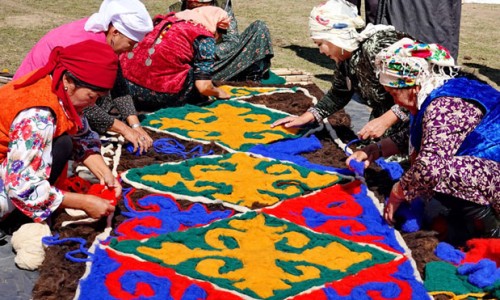The traditional culture of Kyrgyzstan holds significant importance and is readily encountered in everyday life. The customs and traditions of the Kyrgyz people are closely intertwined with the nomadic lifestyle, characteristic of Turkic and Mongolian societies. Nomadism influences various aspects of life, including festivals, artisanal crafts, poetry, music, cuisine, and daily routines. Despite Kyrgyzstan's modernization, these cultural traditions continue to be cherished and honored. Among the most renowned aspects of Kyrgyz culture is the epic "Manas" – an incredibly long poem, which has been orally transmitted from one generation to the next.

As nomads, the Kyrgyz have historically maintained a close relationship with nature. Their lifestyle, from housing to clothing, has been intricately intertwined with natural elements, allowing for adaptation to various environmental conditions. Yurts, their traditional dwellings, are easily portable and adjustable for different seasons. Artifacts like shirdak and tush-kyz (felt carpets and embroidery on the walls), found in yurts, draw inspiration from nature's forms. Even their attire, crafted from natural materials, reflects both practicality and aesthetic appeal, showcasing a tradition passed down through generations with care and reverence.

The Kyrgyz epic “Manas”
The Kyrgyz epic "Manas" stands out as a paramount cultural emblem of Kyrgyzstan and perhaps the longest epic poem globally. Surpassing the Odyssey by twentyfold, it chronicles the life of the warrior Manas, alongside the exploits of his descendants. Over generations, this narrative has been meticulously safeguarded and retold by specialized individuals called epic storytellers, or "manaschis." It was transcribed during the 1800s, with the initial complete version being published in the 1920s. "Manas" has been translated into numerous languages and has seen publication both within the Soviet Union and internationally.

Kyrgyz yurts
Yurts have played a vital role in Kyrgyz culture, serving as more than mere dwellings. They have symbolized familial ties, connection to the land, and the universe, encompassing various life stages from birth to death. Yurts have been intricately woven into the fabric of Kyrgyz culture, influencing important rituals, ceremonies, craftsmanship, and traditional practices throughout history.

Kyrgyz yurts are made of dome-shaped birch branches tied to a lattice, forming vertical walls. The outer layer, traditionally crafted from felt and wool, is easily repairable and weather-resistant. The lattice circle at the yurt's dome, known as the tunduk, holds profound significance as a symbol of familial unity and universe.

Kyrgyz textiles
Kyrgyz textiles have been intricately intertwined with the natural environment of the region. Crafted from materials readily available in the mountainous terrain and its surroundings, such as felt and wool, they often depict motifs inspired by the landscapes, rivers, flora, and fauna indigenous to Kyrgyzstan.

"Shyrdaks" are distinctive felt rugs adorned with patterns that stylize specific aspects of animals, including a dog's tail, mountain goat horns, bird talons, and similar features.
Tush-kiyiz are elaborately embroidered fabric wall carpets, often included as part of a bride's dowry. They typically feature motifs of plants, flowers, and occasionally animals.

Kurak refers to the practice of patchwork sewing, derived from the term "kura," meaning the stitching together or composition of separate pieces. This method is employed to create various items including hats, children's garments, cradle blankets, wedding drapes, mattresses, pillows, saddle covers, bags, or rugs.
Ala-kiyiz represents yet another variation of felted carpets.
Chiy, a herbaceous plant found in the steppe regions, is utilized to weave mats from its dried stems.


